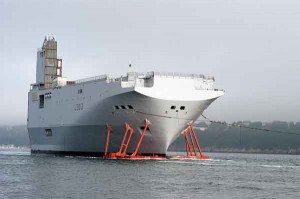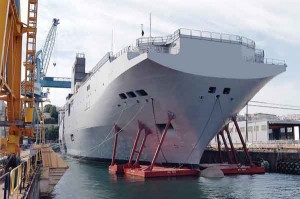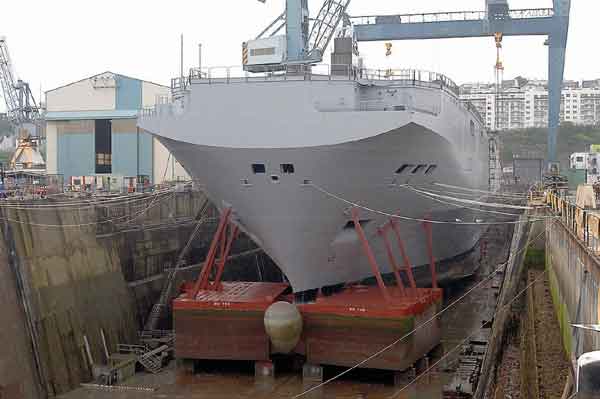International rules that have evolved from the main ‘IMO Conventions and Recommendations’ as well as the ‘EU National Rules’ are not mandatory for warships. Nonetheless, the French Navy decided to adopt a large part of these requirements for its own ships; in particular, for ships conforming to SOLAS and MARPOL regulations.
For this reason, the French Navy chose to take into account various conditions, with regard to its own military requirements, together with the feed back received from naval ships in service.
Needless to say, such a deliberate choice is covered with a formal decision from the Navy’s Chief of Staff: this decision takes the shape of formal written regulations, specifying the universal requirements for the construction of surface warships, including their sea-worthiness.
Based on these requirements, the Technical Department of the Defence Services created an entirely new concept relating to technical regulations for ship construction. The most important regulation pertains to the Classification Society Rules, drawn up on the same lines as those for merchant ships. If necessary, complementary technical rules may be added, concerning storage and handling of ammunition, aviation on board ships, procedure for handling NBC threats, electromagnetic compatibility, special sick-berth fittings, and rules associated with ship’s stealth profile, etc.
 Formulation of technical regulations, the core of which are the ‘Classification Rules’, facilitates better relationship with civilian ship-builders. It also enables better cooperation between navies. Moreover, it is helpful when making design choices for selecting ‘off-the-shelf’ equipment; this technique is much less expensive than the individual designs made by the state shipyards for the Navy.
Formulation of technical regulations, the core of which are the ‘Classification Rules’, facilitates better relationship with civilian ship-builders. It also enables better cooperation between navies. Moreover, it is helpful when making design choices for selecting ‘off-the-shelf’ equipment; this technique is much less expensive than the individual designs made by the state shipyards for the Navy.
The French Navy is actually a trailblazer among the major navies: it is the first Navy to implement the same practices for Warship Classification as those for merchant ships.
The ‘Mistral’ class vessels are the first combat vessels to be compliant with SOLAS and MARPOL (ship cleanliness) rules.
Finally, in several aspects, the standard of warship-building is higher than the one in the civilian shipyards: that should be quite natural, considering it relates to a combat ship. But, in many ways, the French Navy thinks that choosing adapted civilian rules is a great advance.
By adopting this novel practice, the French Navy gave the warship-building industry a new impetus. It is coming closer to the best civilian practices in the field of ship construction, while at the same time adding crucial value for a combatant ship—the ideal choice of using optimum military hardware plus minimum crew size!
Classification of Warships
In the year 2000, the French Navy decided to have its new surface ship-building programs covered by the classification process.
 This decision was based upon the availability of Classification Rules for Warships, developed by Bureau Veritas in cooperation with the French Navy Headquarters, the French procurement agencies, and the French naval shipyard (DCNS).
This decision was based upon the availability of Classification Rules for Warships, developed by Bureau Veritas in cooperation with the French Navy Headquarters, the French procurement agencies, and the French naval shipyard (DCNS).
A working group of ‘Bureau Veritas’ was set up to develop such rules, under the supervision of a Steering Committee composed of representatives from ‘Bureau Veritas’, the naval ship-contractor and the technical body DGA, the French Navy Headquarters, the naval shipyard DCN and a major civil shipyard (Alstom Chantiers de l’Atlantique.)
A co-operative organisation was set up with 12 specialised working groups each dealing with different technical aspects. Specialists of different companies and organisations were involved in each of the above groups to select the existing merchant ship-building rules to be retained in toto, deleted, or adapted for warship construction in disciplines such as Hull design, construction and stability, main propulsion, electric power generation, automation, as well as special shipyard materials, and armour plating for warships.
Intense activity for almost three years resulted in 16 meetings of the Steering Committee and each 15 meetings of each working group.
The process involved a review of the new version of ‘BV Rules 2000 for Merchant Ships’: validate the rules to be retained in toto, identify and delete the rules not relevant for warships, and adapt rules for the military scenario.
An initial version of ‘BV Naval Rules’ was released in 2002 (in French), , then in 2003 (in English). The latest update, dated September 2006, includes the lessons learnt from successive reviews.
Principles of Classification
The classification of ships is achieved by ensuring conformity to the appropriate rules of the classification society, in this case, the Naval regulations.
Classification is carried out in a three-step process:
- Design approval: Detailed approval of all design aspects of the ship’s Hull, generation and distribution of electric power, main propulsion, ship’s stability and safety including structural stability curves, fire protection and fire-fighting devices, escape routes and evacuation, etc.
- Certification of materials and safety-related equipment at the Makers’ works: Main and auxiliary Engines, propulsion systems, insulated bulkheads, fire-fighting equipment, fire detection, electrical cables-Switchboards-Junction Boxes…
- Construction Survey: It includes a Preliminary Meeting, approval of internal shipyard fabrication and quality plan, approval of welders and of welding procedures, survey at the yard’s premises, attendance to tests, Harbour and Sea Trials, issue of Classification Certificates, etc.
Naval Programs Related to Classification
- Force Projection and Command Ship “Tonnerre” and “Mistral” Program (BPC)
The first naval program to benefit from the ‘Classification Rules’ was the BPC construction work, pertaining to two Helicopter and Landing Craft Carriers – “Mistral” & “Tonnerre”- built by DCN and Chantiers de l’Atlantique for the French Navy from 2003 to 2006. They were the first French surface warships to be involved in such a process. Since then ,the French Navy has clearly decided to follow this methodology for all naval ships.
The BPC class is 200 m long with POD propulsion, and six helipads. It can accommodate about 450 to 700 troops on board, depending on the configuration, and can embark 16 helicopters such as the ‘Tiger’ class or the NH 90 type.
This warship has been designed and surveyed for full compliance with the classification rules for ‘Ro-Ro’ passenger ships, as well as SOLAS and MARPOL regulations. In addition, strict Defence Specifications pertaining to NBC and ammunitions have been implemented.
As a result, the warship has the benefit of increased safety standards in terms of fire structural protection, fire-fighting automatic systems, evacuation and escape.
Over and above this application of a “stand-alone” Classification, the rules have facilitated the cooperation between the civil yard “Chantiers de l’Atlantique” in charge of the construction of the vessel’s forward portion (where the crew accommodation spaces are located), and DCN (in charge of the aft portion of the ship) – i.e. the military portion- having the docking and the helicopter landing facilities.
 Construction of the two ships was completed within four years: this is a very tight schedule, for a warship construction program of this magnitude (21600 Tonnes)
Construction of the two ships was completed within four years: this is a very tight schedule, for a warship construction program of this magnitude (21600 Tonnes)
- FREMM PROGRAM (European Multi-purpose Frigates)
The Franco-Italian FREMM program was the second one to benefit from the classification process. It entailed the construction of 27 European Multi-purpose Frigates (17 for France, 10 for Italy). They are 142 meters long, having a displacement of 6000 tons.
‘Bureau Veritas’ of France and RINA of Italy came together of one accord, and evolved a unique set of rules applicable to all 27 ships, called “BV-RINA Rules for FREMM.”
This program provides a higher degree of safety: the SOLAS principle of Main Vertical Zones has been retained, adapted to the needs and constraints of a combat vessel. The fire safety requirements have been derived from the IMO A534 regulations for ships carrying less than 200 special personnel.
French FREMM frigates will also be compliant with the new MARPOL 12 A regulation.
There are two advantages in such a unique design, certified by a common set of rules:
- scaling down of inventory by the use of the same standard for all the 27 ships,
- using commercial equipment “off-the-shelf”, which are ‘Type-Approved’ by the Classification Society.
Thus, by the use of ‘Class-Approved’ automatic Fire-fighting Systems, and by the use of ergonomic principles in the design of the ship’s Bridge, the ship’s crew complement has been reduced to 110, a significant economic saving compared to the earlier frigates.
Aircraft Carrier Project
The third program that will benefit from this classification is the new French Aircraft Carrier, within the ambit of the Anglo-French cooperation for building three aircraft carriers (two CVF for the UK and one PA2 for France).
These aircraft carriers will be 280 m long, with a circa 75 000 tons displacement and a personnel complement from 1 600 to 1 750.
 This is a very complex project, since these carriers are as large as huge passenger ships in terms of their size and the number of crew carried on board with the additional complexity of fixed-wing aircraft and helicopter operations.
This is a very complex project, since these carriers are as large as huge passenger ships in terms of their size and the number of crew carried on board with the additional complexity of fixed-wing aircraft and helicopter operations.
There will be a high level of commonality between French and British designs (90%) although there would be differences due to the use of different types of aircraft. Moreover, the French version would need a catapult on board. The two projects will be certified according to different standards: classification from Bureau Veritas Naval Rules 2006 for the French project, and certification according to Admiralty Defence Standards of the Royal Navy for the British project.
Dupuy De Lôme’ And ‘Alizé’
The AGI ‘Dupuy de Lôme’, an intelligence gathering warship, 102 m in length, and the ‘Alizé’, a 60 m long support vessel, delivered in the year 2004 and 2005 respectively, were also built to Bureau Veritas Rules.
Classification for Naval Ships In-Service
In addition to its decision about new constructions, the French Navy has also decided to maintain the existing naval ships according to a survey regime proposed by the Bureau Veritas :
- Annual survey
- Intermediate survey (Every 3 years)
- Class- renewal survey (Every 6 years).
This survey regime is derived from the unified IACS, applicable to merchant vessels.
The annual survey consists of a thorough visual inspection of all the safety-related items, without any dismantling. The ship remains alongside.
The intermediate survey focuses on the inspection of the ship’s tank capacities and on measurement of tank steel thicknesses, etc.
The class renewal survey involves dry-docking the ship, dismantling major equipment including the propeller shaft, and the inspection and repair/renewal of every part of the ship.
Conclusion
Besides the advantages of safety of the personnel and environmental protection, classification of ships at new-construction stage, combined with maintenance of ships in service, definitely demonstrate that warships of the French Navy are no less safe or less clean than merchant vessels.
The certification of the safety of the vessel by ‘Bureau Veritas’, an independent “third party” recognised by the French Merchant Fleets and some other 130 flag states, represents a strong guarantee for the French Navy Chief of staff, should some external agency investigate the safety of naval ships.
The compliance to these external safety rules, of course, does not impair the Navy’s fighting capability and the ability to combat aggressions, which are covered by additional Defence Specifications.
From the experience gained out of these recent programs, the French Navy is satisfied with the quality of ships built as well as with the services provided by ‘Bureau Veritas.’






